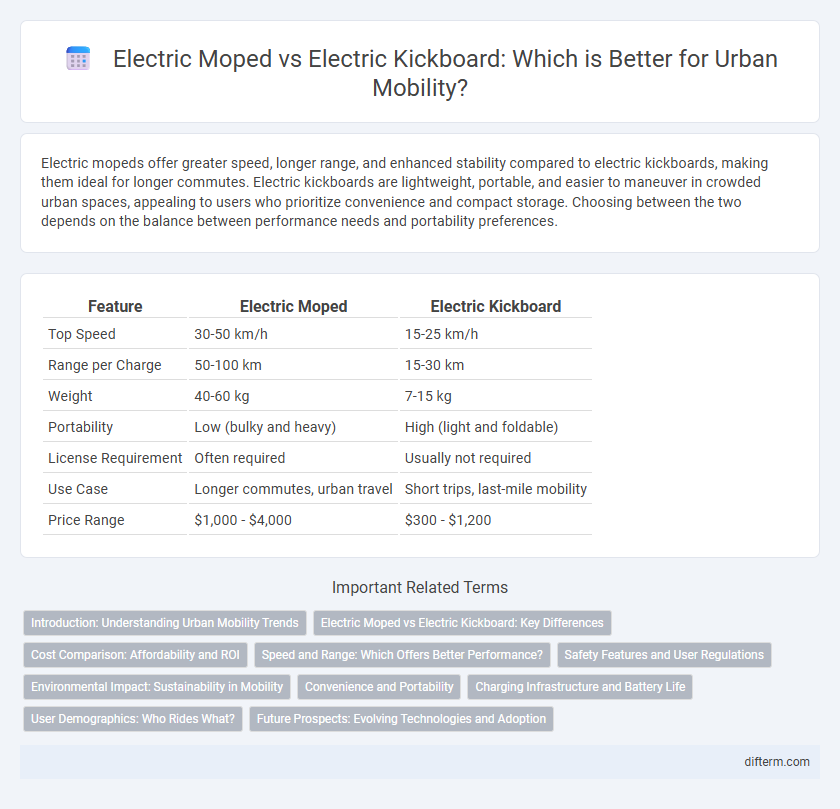Electric mopeds offer greater speed, longer range, and enhanced stability compared to electric kickboards, making them ideal for longer commutes. Electric kickboards are lightweight, portable, and easier to maneuver in crowded urban spaces, appealing to users who prioritize convenience and compact storage. Choosing between the two depends on the balance between performance needs and portability preferences.
Table of Comparison
| Feature | Electric Moped | Electric Kickboard |
|---|---|---|
| Top Speed | 30-50 km/h | 15-25 km/h |
| Range per Charge | 50-100 km | 15-30 km |
| Weight | 40-60 kg | 7-15 kg |
| Portability | Low (bulky and heavy) | High (light and foldable) |
| License Requirement | Often required | Usually not required |
| Use Case | Longer commutes, urban travel | Short trips, last-mile mobility |
| Price Range | $1,000 - $4,000 | $300 - $1,200 |
Introduction: Understanding Urban Mobility Trends
Electric mopeds offer enhanced speed and longer range, making them ideal for extended urban commutes, while electric kickboards provide lightweight, compact solutions perfect for short-distance travel and quick navigation through crowded streets. Urban mobility trends increasingly favor electric vehicles that combine convenience, eco-friendliness, and ease of parking, reflecting growing demand for sustainable transportation alternatives. By comparing battery capacity, speed, and portability, users can select between electric mopeds and kickboards based on their specific commuting needs and city infrastructure.
Electric Moped vs Electric Kickboard: Key Differences
Electric mopeds feature larger batteries and motors, providing higher speeds and longer range compared to electric kickboards, which are more compact and lightweight for short urban commutes. Electric mopeds require a license and registration due to their power and size, whereas electric kickboards often have fewer legal constraints, making them more accessible for casual riders. Safety features differ significantly, with electric mopeds equipped with advanced braking systems and lights, while electric kickboards rely on basic controls suitable for lower-speed travel.
Cost Comparison: Affordability and ROI
Electric mopeds typically offer higher upfront costs ranging from $1,200 to $3,000 compared to electric kickboards priced between $300 and $800, making the latter more affordable for budget-conscious consumers. Considering maintenance, electric mopeds require more frequent servicing and parts replacement, increasing total ownership costs, while electric kickboards incur lower maintenance expenses due to simpler mechanics. The return on investment (ROI) for electric kickboards is generally quicker because of lower initial costs and operational expenses, making them a cost-effective choice for short-distance urban commuting.
Speed and Range: Which Offers Better Performance?
Electric mopeds typically offer higher top speeds, ranging from 25 to 45 mph, compared to electric kickboards, which generally max out between 15 and 25 mph. In terms of range, electric mopeds can travel 30 to 60 miles on a single charge, whereas electric kickboards usually provide 10 to 25 miles. Therefore, electric mopeds deliver superior performance for both speed and distance, making them more suitable for longer commutes and faster travel.
Safety Features and User Regulations
Electric mopeds offer enhanced safety features such as robust frame construction, integrated lighting systems, and mandatory helmet use laws in many regions, promoting rider protection. Electric kickboards generally have lighter frames and lower speed limits, often regulated by local authorities to restrict usage on sidewalks and busy roads. Compliance with user regulations, including speed caps and designated riding zones, is crucial for both vehicles to ensure legal operation and public safety.
Environmental Impact: Sustainability in Mobility
Electric mopeds produce lower carbon emissions compared to gasoline-powered vehicles but typically have larger batteries and higher energy consumption than electric kickboards. Electric kickboards offer a more sustainable urban mobility solution with zero direct emissions, reduced battery size, and lower resource use during production, leading to a smaller environmental footprint. Integrating electric kickboards into daily commutes supports reduced air pollution and energy-efficient transportation in densely populated cities.
Convenience and Portability
Electric mopeds offer greater convenience with longer battery life and higher speeds, making them suitable for extended urban commutes. Electric kickboards excel in portability due to their lightweight design and foldable frames, allowing easy storage and quick transitions to pedestrian travel. Both vehicles enhance urban mobility but cater to different needs: mopeds for sustained travel and kickboards for compact, flexible transport solutions.
Charging Infrastructure and Battery Life
Electric mopeds often feature larger battery capacities ranging from 1.0 to 3.0 kWh, providing extended battery life and longer travel distances compared to electric kickboards, which typically have batteries around 0.2 to 0.6 kWh. Charging infrastructure for electric mopeds includes home chargers and public charging stations optimized for high-capacity batteries, while electric kickboards mainly rely on removable batteries or compact chargers suitable for small battery packs. The availability of rapid charging solutions for mopeds supports quicker turnaround times, whereas kickboards prioritize portability and ease of charging in urban environments.
User Demographics: Who Rides What?
Electric mopeds attract urban commuters aged 25-45 seeking longer travel ranges and greater speed, often for daily work trips and errands. Electric kickboards, favored by younger users aged 16-30, appeal to short-distance travelers prioritizing portability and ease of use in congested city environments. Both vehicles serve distinct mobility needs, with mopeds dominating in suburban and mixed-use areas while kickboards thrive in dense urban centers.
Future Prospects: Evolving Technologies and Adoption
Electric mopeds are expected to benefit from advancements in battery density and smart connectivity, enabling longer ranges and enhanced safety features that appeal to urban commuters. Electric kickboards will continue to see rapid adoption due to their compact design and ease of use, supported by improvements in lightweight materials and foldable mechanisms. Integration with shared mobility platforms and evolving city infrastructure will drive widespread acceptance and innovation for both electric mopeds and kickboards.
electric moped vs electric kickboard Infographic

 difterm.com
difterm.com